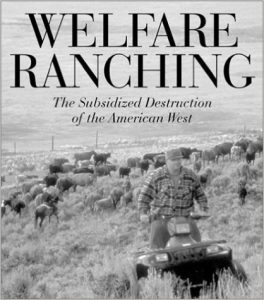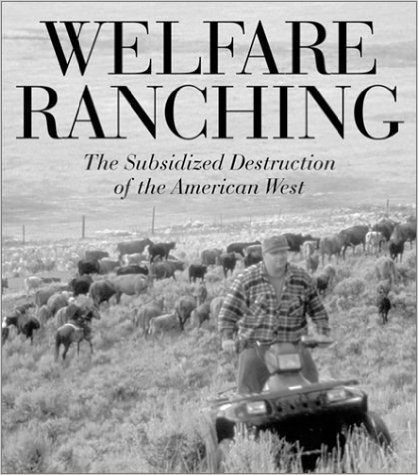
WELFARE RANCHING- destruction of the environment and wildlife at taxpayer expense
GAO: Taxpayers Heavily Subsidizing Ranching on Public Lands, Environmental Damage Unclear Due to Poor Recordkeeping
Washington, D.C. – A Government Accountability Office (GAO) report released today in response to a request by Ranking Member Raúl M. Grijalva reveals the extent of federal ranching subsidies on public land and highlights major data gaps in tracking unauthorized public lands grazing. The report, entitled Unauthorized Grazing: Actions Needed to Improve Tracking and Deterrence Efforts, offers a detailed look at permitted and unpermitted grazing on the approximately 440 million acres of public land managed by the Bureau of Land Management (BLM) and U.S. Forest Service (USFS). The full report is available athttp://bit.ly/29wkYlv.The report highlights the need for greater enforcement of financial penalties for grazing violations and increased data collection on potential serial violators. It also clearly shows that federal land management agencies heavily subsidize ranchers by leasing federal land well below market value – an assessment strongly at odds with repeated right-wing claims of federal neglect of Western ranchers.According to the report, “In grazing year 2016, BLM charged ranchers $2.11 per animal unit month for horses/cattle, and $0.42 for sheep and goats; the Forest Service charged the same rates per head month. According to the National Agricultural Statistics Service, based on the average private grazing land lease rate per animal unit month, the commercial value of forage in western states ranged from $9 to $39 in forage year 2016.”The findings stand in sharp contrast to conservative complaints about public lands ranching. At a Utah forum on federal land management agencies convened by Chairman Bishop in January, Randy Parker of the Utah Farm Bureau Federation claimed, “We are seeing the systematic dismantling of ranchers’ ability to graze their livestock.”
The new report finds that, contrary to right-wing descriptions of federal conservation officials as overbearing, agencies seldom enforce public lands grazing laws and often do not document the violations they observe: “[A]gency staff told GAO that they handle most incidents [of unauthorized grazing] informally – their preferred practice – and do not record them in databases or consistently in paper files, because, in part, they do not consider it a priority. As a result, the agencies have incomplete information on the extent of unauthorized grazing. . . . [M]ost of the Forest Service staff GAO interviewed said that unauthorized grazing penalties are too low to act as an effective deterrent.”
These findings echo GAO’s previous public lands grazing report, published in 1990: “Because many grazing areas are inspected infrequently or not at all during the year, offenders are not likely to be detected. When offenders are detected, BLM frequently exacts no penalties and, for the more serious violations, seldom assesses the minimum penalties its own regulations require. As a result, grazing trespass is not adequately deterred, which can lead to degradation of public rangelands, among other things.”
Grijalva said today that federal agencies’ first responsibility is to ensure the public receives a fair return for the use of public land. Right-wing anti-government rhetoric, he said, should not prevent agencies from enforcing laws written to protect the environment and economy of Western states.
“We know we’re leasing public land at well below market value,” Grijalva said. “What we don’t know nearly enough about is the extent or impact of unauthorized grazing on public lands. The Forest Service and Bureau of Land Management need to bring grazing fees in line with the modern economy and take illegal use of public lands more seriously going forward.”
The Government Accountability Office (GAO) reported the federal government spends at least $144 million annually managing private livestock grazing on federal public lands, but collects only $21 million in grazing fees—for a net loss of at least $123 million per year.
The GAO admited its report is incomplete because several agencies, including the Natural Resources Conservation Service and the Environmental Protection Agency, which spend millions of dollars mitigating grazing effects such as soil erosion, weed incursion, and water pollution, did not provide estimates of their grazing related costs to the GAO. Other programs that benefit both private and public lands ranchers, such as the “Livestock Compensation Program,” were also not included in the total subsidy to public lands ranchers.
Considering the additional direct and indirect costs not included in the GAO report,
economists have estimated that the federal public lands grazing on Bureau of Land Management and Forest Service lands may cost as much as $500 million to $1 billion annually.
The Fiscal Irresponsibility of Public Lands Ranching
The cost of public lands ranching to American taxpayers is enormous. The current public land grazing fee of $1.35 per month for one cow and her calf is woefully below market value. Direct government expenditures to administer public land grazing constitute an annual net loss to the taxpayers of at least $123 million and more than $500 million when indirect costs are accounted for. As much as 96% of these public dollars are spent to enhance livestock production in direct conflict with legal mandates to restore the health of public lands.
For all of this public expense, public lands ranching fails to demonstrate any significant economic contributions to rural economies. Hobby ranchers and corporate-entities hold the lion’s share of grazing permits on hundreds of millions of acres of public lands. Most of the rest of public land ranchers rely on service jobs in small towns as their primary source of income. Rural communities support public land ranchers not the other way around.
Domestic livestock gazing has been the greatest environmental calamity ever to befall the Western United States.
–George Wuerthner, author and ecologist (Wuerthner 1989)
For example, the bones of more than 500 free-roaming horses, shot by public lands ranchers to reduce competition with their cattle, were found recently on BLM land in central Nevada. This gruesome discovery probably created for a few weeks more public furor against public lands ranching than all the industry’s other effects combined -effects which during that time period undoubtedly caused an overall environmental impact hundreds of times greater than the horse killings.

Comments
I am sick and tired of having MY ta dollars being used to slaughter our American Wolves!!…I want to know who it is that I need to contact, in order that my tax dollars be returned to ME for the killings that I have not authorized my tax dollars to be used. I will find a way to start a country wide movement and I will through my means get to every necessary area that I can find to let the American people know what exactly is happening to our wolves by the greedy cattle ranchers, who do not belong on GOVERNMENT PROPERTY~!!…MILLIONS OF DOLLARS FROM WE TAXPAYERS ARE BEING USED TO KILL OFF OUR WILDLIFE FOR NO OTHER REASON THAN A MONEY MAKING PROPOSITION!!!…
Thank you Arlene, we are trying to bring a huge Voice to WDFW meeting September 14th and 15th 😉 Hold Your Breath Its looking quite Promising that we will gain the Voice support it will Take
This has been a very big problem for a very long time now but now as become a nightmare. It is affecting our environment, wolves and all wildlife. Many times we have tried to reason with Cattlemen but with no success from very few of them. Livestock are using public land for grazing leaving the land severely depleted for decades. They damage the soil, spreading unwanted weeds, polluting water, depriving native wildlife of forage and shelter and even contributing to Global warming. A lot of these problems could be resolved by some responsible ranches enclosing their cattle with good fencing , drilled wells supervision their waste picked up and am sure many good ways. Instead we have irresponsible ranchers bring their cattle on public land near wolve dens who have pups to protect and are very family orientated. These cattle are left unsupervised with taking a risk that any big wildlife can on occasion few and far about kill one of them. I would think this is very tempting on these wildlife animals. Then this is where the cost of your hard earned money as a taxpayer comes in. For every cow killed by wildlife the government pays the cattlemen very good money for their loss and are left to clean up all the land left in such a terrible state. Millions are paid out for the cattlemen’s irresponsible ways. The worst and very sad part of this story behind all this is our wolves and wildlife are always blamed for all the cattlemen ‘s problems and they take the opportunity of getting whole WOLVE packs slaughtering so inhumane and with hate in their hearts. If there was a problem wolf among a pack they should monitor him and not kill the whole pack. This is a few times now that packs are hunted down like scum and sometimes leaving wolf pups to fend for themselves which is not good for them. This also leaves such disrespect for our Native’s scarred rights that they live and strive on. The time as come to end these ridiculous costs and disrespect for all our wildlife who are now fighting to stay alive and on endangered species act that is not respected as well and the Natives rights. Biologists and science have proven so much about the wolves and wildlife and most agree that these wolves have feelings and grieve just has humans. It’s pretty bad when they start getting death threats like one recently got just for speaking the truth. So in closing I think it’s time for the government to put a stop to all your money spend on cattle and their damage and definitely start to protect the wolves and wildlife even yourself wanting to use these public lands which are so unbearable to use. Let us spread the word to protect the wolves and wildlife before they are all extinct. Very close to that now. Thank you for listening to my concerns.